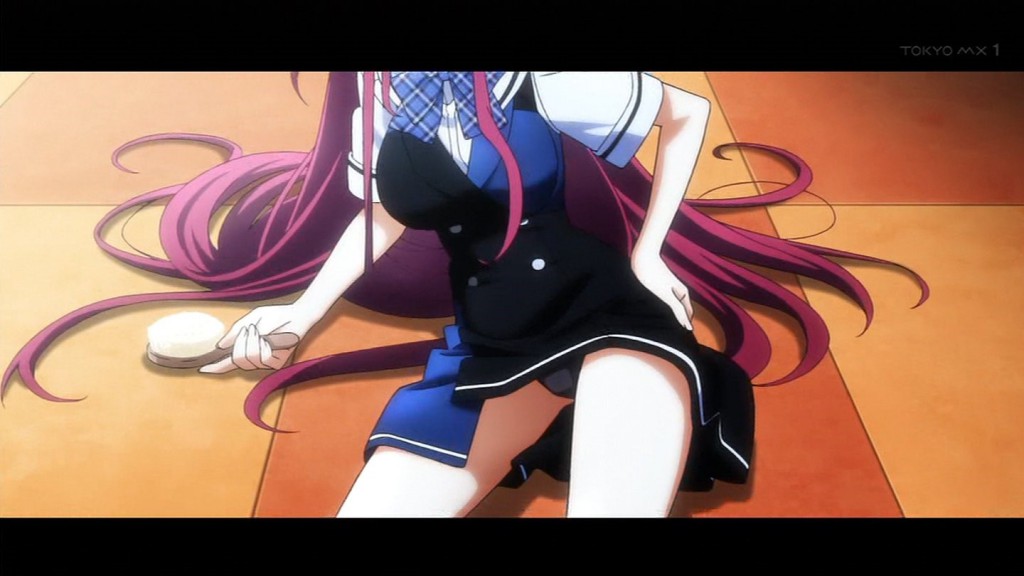Attack of the OVA #3 – Fifty Shades of “Gray”
August 9th, 2015 in Anime, General Reviews, The Fruit of Grisaia OVA by The Droid

The OVA for “The Fruit of Grisaia” (or “The Gray-Colored Fruit”) is designed to keep you interested in the show, as a movie (in theory) comes out in April and a new series follows shortly thereafter, but they come off as more unrestricted ecchi. All of the ladies seem to want to do the Wild Thing with Yūji Kazami, but it is done more for our benefit as the viewer than for anything that Yuri might want, or that the ladies are seeking.
I do not need to see a woman, dressed as a Playboy Bunny, riding a giant carrot like Slim Pickens did with that nuke in “Dr. Strangelove” or some girl who gives Yuri a real scrub down in the bath, washing everything including his shower nozzle. No, that’s not a euphemism; she really washes down the shower nozzle. Look, it just might be better for you to watch the shows (they run about six or so minutes each) to understand why they do what they do, as it does not make a lick of real sense, either as an OVA or in the general run of the show. And to make matters worse, it comes off as a painful obligation to do these histrionics, rather than a blossoming girl, experiencing the pangs of first love and true romance and….oh, just take off your clothes. Or, as seen above, a tantalizing glimpse of panties. (more…)
Tags: Drama, Harem, Psychological, Romance, School
Attack of the OVA #2 – “High School” Madness
August 6th, 2015 in Anime, General Reviews, High School DxD by The Droid

For those of you who have been following this show, “High School DxD” has two big things going for it….the left one and the right one! I place this show in the crowd with other boson-heavy offerings like “Sekerei”, “High School of the Dead”, Ikki Tousen” and “Maken-Ki” (to name but a few) and the OVAs now push it to the maximum, straining the limits of everything as much as Rias’ blouse is strained by her….achievements.
The OVAs are nothing more than to offer window-fogging reasons to glom onto unfettered bosoms. The shows are being done for two reasons: (a) a story like this in the regular run of episodes would impair the show’s ability to promote the main plot line and (b) to highlight the coming of the third season of the show (which will probably be concluded by the time this review hits the street). (more…)
Tags: Comedy, Demons, Ecchi, Romance, School
The Gift of the “Magi”
July 26th, 2015 in Anime, General Reviews, Magimoji Rurumo by The Droid

This is a kind of a magical girl show, but “Magimoji Rurumo” (or “Magi Moji Rurumo”) does not follow the same arc as others of this genre. It all starts at school (as does a huge amount of animes and mangas).
Kota Shibaki (that’s him on her right) is a high-school boy whose only interest is girls, but he is so openly perverted about it, the ladies avoid him. Well, he IS kinda icky. One day, he finds a book in the library about how to summon witches. (I don’t remember my library having books like this. Sure, maybe a science book talking about the just-launched Sputnik satellite, but we can’t ever be up to date on things.)
He tries it as a joke, but it turns out to be the real thing: an apprentice witch named Rurumo appears, to grant him a wish. Shibaki helps Rurumo and she, in return, refuses to take his soul. Well, that’s the nature of contracts with witches. Time passes and Shibaki wishes he could see Rurumo again. His wish is granted immediately as Rurumo falls from the sky and crash-lands in front of him. Well, a lot has happened. He finds out that as punishment for Rurumo not taking his soul, she’s been busted down to an apprentice demon. (more…)
Tags: Comedy, Ecchi, Fantasy, Magic, School, Shounen
The “Wolf” at the Door
June 25th, 2015 in Ookami Shoujo to Kuro Ouji by The Droid

As I mentioned earlier, there has been a lot of romantic comedies coming out. This one “Wolf Girl and Black Prince” (“Ōkami Shōjo to Kuro Ōji”) is an interesting take on things in the realm of high school love.
The story centers around Erika Shinohara, a 16-year-old girl who tells her friends about her romantic exploits, but she actually has no boyfriend. Well, you had best produce, so she claims that the handsome boy in a candid photo on her phone is her boyfriend, but it turns out that boy is a schoolmate named Kyōya Sata. She has no choice but to make him her fake boyfriend. Unfortunately, Sata may look like a sweet person, but he is actually an ultra-black-hearted sadist. Sata takes advantage of Erika’s weakness and treats her like his dog.
And, I mean, he is really mean. He doesn’t exploit her or really blackmails her, but he is as cold as they come and Erika feels trapped into this all. This is where some of my resentment crops up. A couple of opportunities arise that she could dump him and just write it off as ‘things didn’t work out.’ It also brings up the second question: what if her two friends, Marin Tachibana and Aki Tezuka, are also faking it and they really don’t have boyfriends? Just a thought. (more…)
Tags: Comedy, Romance, School, Shoujo
They Call Me “Trinity”
June 21st, 2015 in Trinity Seven by The Droid

Well, we have another entry into the magical school genre, but this one tries to be something more than, say, “Negima!” or “The Irregular”. But things get muddled. Welcome to the world of “Trinity Seven”.
Kasuga Arata (do you need help in finding the guy?) lived a normal life together with his childhood friend and cousin, Hijiri Kasuga, in a small town. However, everything changed on the day of the Black Sun, and a magus (mage) appeared before him. The Black Sun caused the Breakdown Phenomenon which destroyed the town where he lived. Because of this, his normal life was artificially reconstructed by a grimoire that his childhood friend had left. The appearance of the magus led him to a new life in the Royal Biblia Academy and meeting the members of the Trinity Seven. And who are these members? I am glad you asked! From left to right, we have: (more…)
Tags: Comedy, Romance, School, Shoujo
“Monthly” Dues
May 21st, 2015 in Gekkan Shoujo Nozaki-kun by The Droid

As a bother-in-arms companion piece to “Denkigai no Hon’ya-san”, we have “Gekkan Shōjo Nozaki-kun” (“Monthly Girls’ Nozaki-kun”), which tells the tale of a manga artist who is somewhat successful in his endeavor.
High school student Chiyo Sakura (red head up there) has a crush on schoolmate Umetaro Nozaki (the one off her left). When she confesses her love to him, he mistakes her for a fan and gives her an autograph. When she says that she always wants to be with him, he invites her to his house and has her help on some drawings. Chiyo discovers that Nozaki is actually the renowned manga artist Sakiko Yumeno. She then agrees to be his assistant in order to get closer to him. As they work on his manga Let’s Fall in Love, they encounter other schoolmates who assist them or serve as inspirations for characters in the stories. (more…)
Tags: Comedy, Romance, School, Shounen
Short Run Series XXI – “Holy” Cow!
May 10th, 2015 in Holy Knight, Short Run Series by The Droid

When I started doing these Short Run reviews, I asked myself “When is an OVA not an OVA?” After a couple of years, I came up with an answer that I can work with. It is an OVA if there is a full show that it can be tethered to. So, when “Attack on Titan” or “Sword Art Online” have their little things, those are OVAs, as there is a show that it can be tied to. If it is something like “Eiken” or “Jungre de Ikou”, it is a short run series, as there was no show for it to be based from and is a stand-alone short run.
Now, with all that being said, I comment about this short-run item, “Holy Knight”. It comes in at a mere two episodes but leaves a lot on the table, kind of like going to an All-you-can-eat smorgasbord and then, after getting all of it to your table, you get up and get out after one bite. What? You’re leaving that all behind? What gives? What gives, indeed.
The tale starts out simple enough. An entire village is killed off, save for the child, Lilith Kishimoto. There is something odd or special about these farm folk, thus triggering their massacre. Here’s where the first problem occurs. The raid appears to have taken place during mediaeval times, as we are wielding swords and wearing armor. When Lilith grows up, in what appears to be a span of 10 years, it is certainly the modern times, with cell phones and airplanes and Justin Bieber posters. Lilith has grown into the fine woman you see before you, but she has a task. This is a three part task. I can only tell you the first part, as the other parts are major plot points. (more…)
Tags: Ecchi, Fantasy, School, Seinen, Supernatural, Vampire
A Bowl of “Fruit”
April 26th, 2015 in Gurizaia no Kajitsu by The Droid

I’m not really certain how to take Le Fruit de la Grisaia (“Gurizaia no Kajitsu” or “The Fruit of the Grisaia”), as it doesn’t make a whole lot of sense, as much is kept hidden from you and you must take a kind of voyage of discovery to understand it all.
Yūji Kazami (the only guy) transfers to Mihama Academy, a school with only five female students and prison-like features. Every student in the school have their own “circumstances” for being there, but Yūji is not required to do anything about their situation, as he asked for a normal student life. This is funny, as there is nothing ‘normal’ about him or the school. He has a questionable and/or unsavory past, which he tries to forget, but not even a zebra can change its stripes.
The five ladies, whom he shares an almost empty classroom with, are (left to right):
Sachi Komine. The maid. She always wears the maid outfit as a sense of duty.
Amane Suou. She is kind of the house mother and wants to seduce Yuji
Makina Irisu. Although innocent and carefree, she suffered a deep emotional shock
Michiru Matsushima. She is standing atop that thing and has a split personality, so you never know who you are talking to.
Yumiko Sakaki (far right). Don’t mess with her, as she wields a box cutter with devastating results. (more…)
Tags: Drama, Harem, Psychological, Romance, School
“Everyday” People
March 19th, 2015 in Anime, General Reviews, When Supernatural Battles Became Commonplace by The Droid

This is another show that started off with a good idea and then did nothing with it. It suffered from the first problem, in what is the name of the crfapping show? The search has it come up as “When Supernatural Battles Became Commonplace” (“Inō-Batoru wa Nichijō-kei no Naka de”), but it is also known in Japan as “Inou Battle Within Everyday Life” and “Inou-Battle in the Usually Daze.”
We are in Senkō High School’s Literature Club, who is reading “Hunger Game” or “Divergent” or “Fifty Shades of Gray”. The story focuses on its five members (from right to left) who are: Tomoyo Kanzaki, Hatoko Kushikawa, Jurai Andō, Chifuyu Himeki and Sayumi Takanashi. They have all developed superpowers from a strange and bizarre incident. These superpowers (such as they are) have now become a part of their everyday lives, as they battle against others wielding similar powers.
The sixth person, Mirei Kudō, is not part of the club, but the Student Council president, who also has obtained these powers. It’s just that the powers seem a bit limited. Slow down time or manipulate the basic elements or create matter or space. Then, once they figure out how to use these powers, they…………do nothing with them. They have a hard time understanding these powers anyway, but what do you do with them? There was an old “Saturday Night Live” sketch, “The Interesting Four”, superheroes with marginal powers, like Weather Woman, who can raise or lower the temperature in a room by 17 degrees. These folks are kind of like that. (more…)
Tags: Comedy, Romance, School, Slice of Life, Supernatural
Space “Invaders”
March 12th, 2015 in Anime, General Reviews, Invaders of the Rokujyōma by The Droid

This is another of those ‘move-in’ animes, but done with a lot more interest and characters. “Invaders of the Rokujyōma!?” (“Rokujōma no Shinryakusha!?”, “Invaders of the Six-Tatami Mat Room!?”) starts off with Kōtarō Satomi (can you find the studly stud?). He decided that he wanted to live on his own when he began high school, and chose Room 106 of Corona House because it was cheap. (Dude, beware of room rents that are way too low. He’s paying 5000 yen a month! Look what happened!) Unfortunately, Kōtarō soon discovers that numerous otherworldly and supernatural girls also want his room for various reasons of their own. Well, he isn’t going to give it up ($50 a month? You can’t even get a storage shed for that!), and the ladies equally aren’t about to back down. As a result, Kōtarō and the girls find themselves forced to live together as they try to settle just who ends up with the room.
Let us meet all of the players, eh? From left to right:
Theiamillis Gre Fortorthe. Called Theia or Tulip, she is an intergalactic alien princess from planet Fortorthe. She must capture the room and subdue Kōtarō to prove her worthiness as a successor to the throne.
Shizuka Kasagi. She is the landlady of Corona house and had all the participants sign a contract regarding the room competition.
Yurika Nijino. She is a genuine magical girl, but a bit clumsy. The room contains high levels of magical power that she needs.
Kotaro. (more…)
Tags: Comedy, Harem, Romance, School, Supernatural









